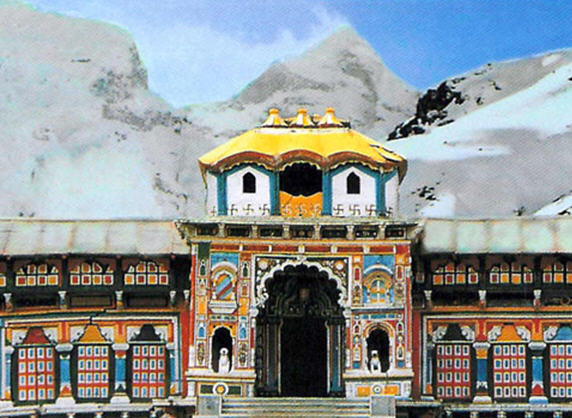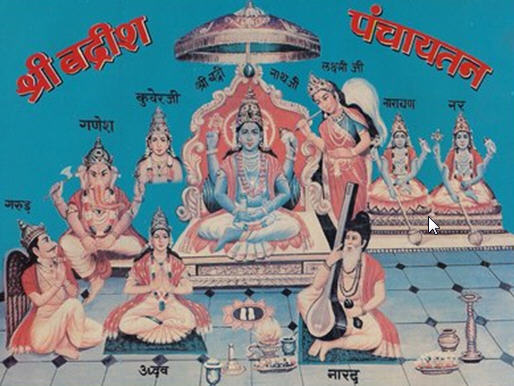Badrinath is the abode of the Nara Narayana sages and is a great place of pilgrimage. According to the Srimad Bhagavatam, even five thousand years ago this holy place was being visited, by such holy persons as Uddhava, and even at that time the place was known to be very old. It is one of the eight self-manifested holy tirthas in India (Svayam Vyakta Kshetras).

There are four dhamas which represent the planets of the spiritual sky, consisting of the brahmajyoti and the Vaikunthas. These are Badrinath, Rameswaram, Jagannath Puri, and Dwarka. Faithful pilgrims visit all these holy places for perfection of spiritual realization. Badrinath is a very important pilgrimage place and is very dear to Lord Krishna. Badri is the name of the Ilandai tree, which is a favorite of Maha-Lakshmi.
Scriptural References:
A statement from the Srimad Bhagavatam (3.4.22) – “There in Badrikashram the Personality of Godhead, in his incarnation as the sages Nara and Narayana, had been undergoing great penance since time immemorial for the welfare of all living entities.”
The Skanda Purana says: “There are several sacred shrines in heaven, on earth, and in hell; but there is no shrine like Badrinath.”
Badrinath is also called “Narada Kshetram” since Narada Muni attained liberation here in five days. Gautama Rishi, Kapila, and Kasyapa are said to have come here, and Sankaracharya established a temple here. Sankaracharya visited here some 1,225 years ago; Ramanujacharya visited 955 years ago; and Madhvacharya visited twice about 735 years ago.
During the season; about 250,000 pilgrims visit Badrinath. Pilgrims chant “Bolo Badri Vishal ki jai” and “Bolo “Badri Narayana ki jai.”
Badrinath is on a small plateau between Narayana Parvat mountain and the Alakananda River. The Nara and Narayana peaks tower over Badrinath. The fantastic Neelkantha Mountain is 6,560m. Badrinath is located 301 km north of Rishikesh. From Gaurikund (near Kedarnath) to Badrinath by road is 233 km.
a) Badrinath Temple
The temple of Badrinatha is located across the Alakananda River. We can easily see the temple from some distance away. After crossing the bridge over the Alaknanda River, we walk up the steps toward the temple. This temple is full of ancient stone carvings. The murti of Lord Badrinath is self manifested from a 213m (2 ft) high black shaligram-shila. He is also called Badri Vishal or Badrinarayana. His details are not very distinct due to weathering, since he was thrown into Narada Kund for several years. The canopy over the Deities is covered with a sheet of pure gold. When Buddhism was in its prime, the deity somehow was neglected and thrown into Narada Kund where He stayed for several years. Later it was again installed by Sankaracharya, who recovered the Deity from Narada Kund.
Darshan
Lord Badrinath is sitting meditating in the padmasana (lotus yogic posture). As you look at the Deities, standing to the right side is Uddhava. To the far right side are Nara and Narayana. Narada Muni is kneeling in front on the right side and is difficult to see. On the left side are Kubera, the god of wealth, and a silver Ganesh. Garuda is kneeling in front, to the left of Badrinarayana
. 
Within the temple enclosure, to the left of the main temple building, is a separate shrine dedicated to Lakshmi Devi and the Gaddi (sitting place) of Adi Sankaracharya, just outside the exit door of the temple. The Lakshmi Temple is painted red in front. The temple dedicated to Sankaracharya is said to mark his sitting place while he was in Badrinath.
Timings
Badrinath stays closed 6 months a year from Deepavali all the way until the full moon day in the month of Chittirai (late spring in the Himalayas). The temple is open six months of the year, May to October. The priests of the temple perform their worship (puja) in Joshimath, 50km south, the rest of the year. Before they close the temple in November, they perform one last puja and leave the ghee lamps in the temple lit. Six months later, in the month of May, they return to open the temple and find the ghee lamps still lit. It is said that the great sage Narada Muni along with other demigods come during the winter months to carry on the worship.
The temple priests are Nambudiri Brahmins from Kerala.
The Nirmalya darshan of Badarinarayana in the early morning is the most auspicious time to view the Deity. The present temple is about 400 years old. The temple is open from 6.30 am to 1 pm and 4pm to 9 pm. Waiting time to enter the temple in the afternoon is a half hour or more. If you come in the morning, you can expect to wait an hour to enter the temple.
It is possible for several people to view the Deities at one time.
Story
The tradition of this temple is explained as follows: Since the history of this temple is so old, the only way we can understand how it came to be is by the explanations in the Puranas. In Satya-yuga, the Lord lived at Badarikashrama (Badrinatha) in a visible form. In Treta-yuga, the sages saw the Lord through the practice of yoga. Then during the age of Dvapara-yuga, it became difficult even for the sages to see the Lord. So then the sages and even the demigods prayed to the Lord, ‘You are our only supporter, please do not leave this place and ourselves.”
Being pleased by their devotion, the Supreme said, “My dear ones and saints! After some time Kali-yuga will start. People in that age will be full of sins, wickedness, pride, and without any pious action. So I cannot stay in a visible form before them. But here under Narada Shila in the Alaknanda, there is a divine image of mine, which you may take and establish. If one sees that image, he will get the same reward of seeing me in visible form.”
After that, Brahma and the other gods took that image out of the Narada Kund and asked Visvakarma, the architect of the gods, to build a temple, after which they established the deity there. Narada Muni was made their official priest, and a rule was made that the deity would be worshiped for six months by human beings, and the other six months by the gods. And this rule is still followed to this day.
In the Skanda Purana another story is told relating how the deity of Badrivishal was established. Therein it is explained that Lord Shankar (Shiva) told his son Skanda that in Kali-yuga, he would personally come in form of a saint & take the deity out from Narada Kund and install it. And by seeing the deity, all the sins of a person will be removed in a moment, just as the herd of elephants run away by seeing a lion. Accordingly Lord Shankara took birth as Shankaracharya and established the deity of Sri Badrinathji for the general good of all people.
How this happened is further related. At the tender age of twelve, Shankaracharya went to Badarikashrama after a hard three months of travel up into the mountains with his pupils. He took bath in the hot springs of Taptakund and went into the temple, but the four-armed form of Narayana that had been established by the rishis in Satya-yuga was not there. In its place was a shalagram-shila stone, which is considered the same as the Lord. But Shankaracharya went outside the temple with a heavy heart, followed by the temple priests. He asked them, “Why is the temple without Narayana’s form? I have heard that the Lord resides here in this pious place for the last four yugas.”
The priests replied, “Because of the tyranny of Chinese robbers, our ancestors hid that form of the Lord in the nearby kund. But after that it was difficult to find. So from that time on we have allowed the shalagram-shila to reside on the altar.” So Shankaracharya asked them if the form of the Lord could be found, would they install it and worship it in the temple. The priests all agreed.
Shankaracharya then step down to the kund and meditated, and then went into the water. The priests asked him not to go since there was a current below in which many people had lost their lives. But Shankaracharya did not listen. He went deep into the kund and pulled out a deity of Lord Narayana to everyone’s astonishment. But the fingers on the right hand of the deity were broken, so he went back in and pulled out another deity, but the same fingers were broken. Then he did that a third time and became perplexed until a voice told him, “Shankara, you need not be confused. In this Kali-yuga, only this broken form will be worshiped.” So in this way, Shankaracharya came out of the water with the deity and installed it in the temple. He established one of his disciples, a Nambudri Brahmana, for doing the worship. In this way, the deity and the temple worship were reestablished by Sri Shankaracharya. Today, people of all races, creeds, religions, and communities go there with respect to see the deity of Lord Narayana called as Lord Badrivishal.